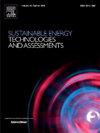Hydrogen at home: The current and future landscape of green hydrogen in residential settings
IF 7.1
2区 工程技术
Q1 ENERGY & FUELS
Sustainable Energy Technologies and Assessments
Pub Date : 2024-11-01
DOI:10.1016/j.seta.2024.104058
引用次数: 0
Abstract
Green hydrogen and electro-fuels have emerged as strong alternatives for conventional fossil fuels due to the urgent need to transition to sustainable energy sources, especially in cases where direct electrification is not feasible. The global surge in green hydrogen projects signifies a commitment to a sustainable future, utilising hydrogen as an adaptable and environmentally friendly energy carrier. However, economic viability is challenged by varying costs of renewable energy sources. Overcoming barriers such as expanding electrolysis capacity, regulatory frameworks, safety standards, and establishing infrastructure are critical for advancing the green hydrogen economy. This paper conducts a critical analysis of recent literature and institutional reports to gain a deeper understanding of the current state of play. Through comprehensive analysis and comparison, the paper offers a detailed overview of green hydrogen production techniques, storage technologies, transportation infrastructures, and real-world implementations. It presents a detailed analysis of the current landscape of global green hydrogen production, offering insights into the specific technical procedures governing its transmission through advanced distribution systems. This research paper also explores the economic feasibility of implementing green hydrogen in residential settings. The key findings highlight various options for implementing green hydrogen setups in homes. The authors recommend a synergistic approach involving solar photovoltaic systems, electrolysers, and hydrogen fuel cells as a progressive step towards achieving complete self-sufficiency using renewable energy sources. The study envisions that green hydrogen generated at homes could potentially be harnessed for commercial purposes. While acknowledging the higher initial investment due to the higher cost of fuel cells and electrolysers, the paper highlights the long-term viability and sustainability of such integrated systems. In its conclusion, the paper illuminates the transformative potential of green hydrogen in residential applications, shedding light on its manifold benefits in shaping a sustainable and environmentally conscious future.
家庭氢能:住宅环境中绿色氢气的现状和未来前景
由于迫切需要向可持续能源过渡,特别是在直接电气化不可行的情况下,绿色氢气和电燃料已成为传统化石燃料的有力替代品。全球绿色氢能项目的激增标志着对可持续未来的承诺,利用氢能作为一种适应性强且环保的能源载体。然而,由于可再生能源的成本各不相同,经济可行性受到了挑战。克服诸如扩大电解能力、监管框架、安全标准和建立基础设施等障碍对于推进绿色氢经济至关重要。本文对近期的文献和机构报告进行了批判性分析,以深入了解目前的发展状况。通过综合分析和比较,本文详细概述了绿色氢气生产技术、存储技术、运输基础设施和实际应用。论文详细分析了全球绿色制氢的现状,并深入探讨了通过先进的配送系统传输氢气的具体技术流程。本研究论文还探讨了在住宅环境中实施绿色制氢的经济可行性。主要研究结果强调了在住宅中实施绿色制氢装置的各种方案。作者建议采用太阳能光伏系统、电解槽和氢燃料电池的协同方法,作为利用可再生能源实现完全自给自足的渐进步骤。研究设想,家庭产生的绿色氢气有可能被用于商业目的。论文承认,由于燃料电池和电解槽成本较高,初始投资也较高,但强调了这种集成系统的长期可行性和可持续性。最后,论文阐明了绿色氢气在住宅应用中的变革潜力,揭示了绿色氢气在塑造可持续和具有环保意识的未来方面的多重益处。
本文章由计算机程序翻译,如有差异,请以英文原文为准。
求助全文
约1分钟内获得全文
求助全文
来源期刊

Sustainable Energy Technologies and Assessments
Energy-Renewable Energy, Sustainability and the Environment
CiteScore
12.70
自引率
12.50%
发文量
1091
期刊介绍:
Encouraging a transition to a sustainable energy future is imperative for our world. Technologies that enable this shift in various sectors like transportation, heating, and power systems are of utmost importance. Sustainable Energy Technologies and Assessments welcomes papers focusing on a range of aspects and levels of technological advancements in energy generation and utilization. The aim is to reduce the negative environmental impact associated with energy production and consumption, spanning from laboratory experiments to real-world applications in the commercial sector.
 求助内容:
求助内容: 应助结果提醒方式:
应助结果提醒方式:


